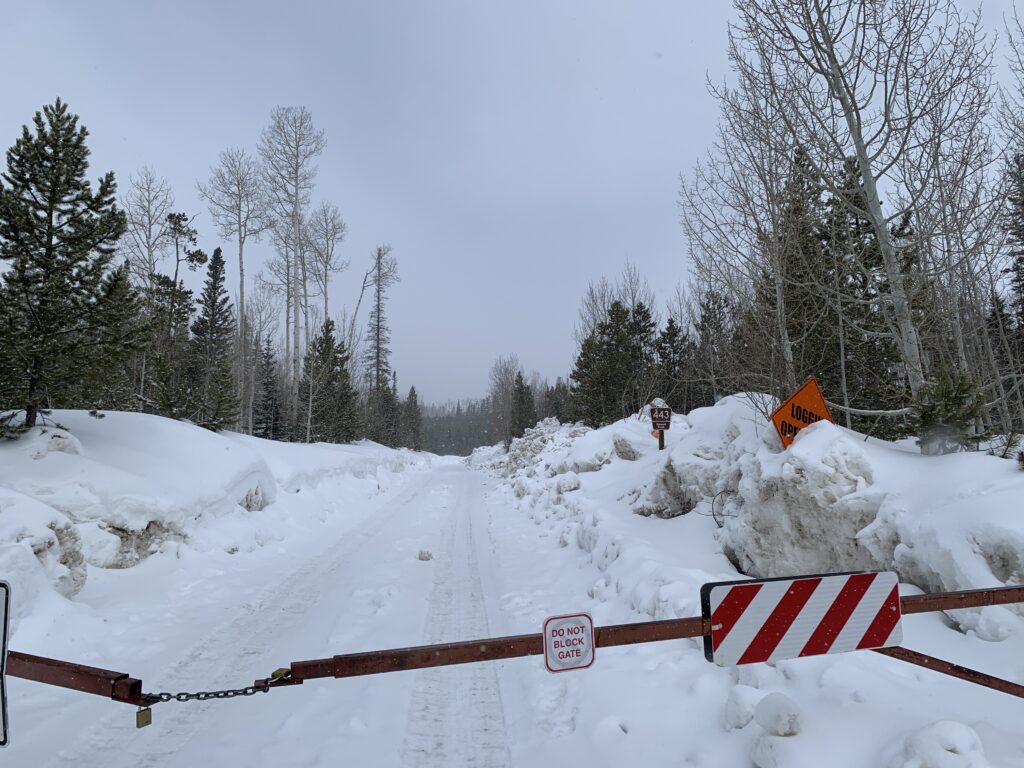
Photo: Jake Barker
One project in particular in Wyoming has emerged in the national conversation concerning public forest management. The Medicine-Bow Routt and Thunder Basin Grassland National Forest (MBRTB) manages forest and grassland in Wyoming and Colorado, and is several years into the implementation of a landscape-scale forest resilience project. Supported by the 2003 Healthy Forests Restoration Act, the Landscape Vegetation Analysis (LaVA) project identifies priority areas within the Medicine Bow forest for fuels reduction and for forest restoration, in response to tree mortality from epidemics causes by the mountain pine beetle (1990s to 2010s) and the spruce bark beetle (ongoing). Through mechanical, hand, and prescribed fire methods, LaVA treatments are designed to reduce fuel loads, promote regeneration of aspen and lodgepole pine, protect mature and old-growth stands, provide a source of timber for local sawmills, and reduce risk of falling trees for recreation and fire crews.
In September of 2020, the Mullen Fire ignited in the Savage Run Wilderness, burning over 175,000 acres in a month, with the majority of the area burned occuring within the project boundary. Normally, this would halt a project in its tracks, even after the multi-year scoping, public engagement, and NEPA process. But given the flexibility built into the decision, the Forest was able to move forward with LaVA. Focus areas within the burn perimeter were reassessed for post-fire restoration, road-side hazard tree removal, and tree regeneration.
Beyond being able to pivot to continue with project implementation, the local Forest Service officers are proud of LaVA, both in the planning process and in the first years of work, and continue to prioritize communication and engagement with the public. (Check out the project’s StoryMap with a tab to provide feedback ) Given the scale of the vision, LaVA’s final form was significantly impacted by public input during scoping and following the draft Environmental Impact Statement (EIS). Additionally, many of the priority areas and future projects have been developed with partners, like the Mule Deer Foundation, regional conservation districts, and the Wyoming Department of Forestry. While LaVA continues forward with implementation, with initial grants from Natural Resources Conservation Service (NRCS), the project coordinator and the districts involved are working hard to ensure that they can find the funding and workforce needed to carry out the projects as planned. But the conversation continues to expand, drawing the attention of organizations like the World Resources Institute and The Nature Conservancy. Most importantly, as with other forest restoration projects, LaVA relies on the partnerships it has crafted over many years with local landowners, ranchers, scientists, conservation districts, urban and rural communities.
TNC’s recent Ecosystem Service Valuation of Wyoming’s Forests report shows that ranging from recreation and tourism, to wildlife habitat, to water supply and storage, and climate regulation, Wyoming forests provide between $22.3 billion to $28.8 billion of benefits each year. Agriculture and timber, though easier to value, continue to play a role in this equation. Wyoming forests are at a unique confluence of diverse interests, so deploying forest restoration is difficult, both operationally and financially. Even though there is a clear, tangible need for restoration, there is limited existing wood products infrastructure, like logging companies and mills, to carry out thinnings and harvests. Operators to carry out logging operations are hard to come by and there are only a few destinations for the wood. For example, in the case of the Medicine Bow Forest, the salvage harvests of dead lodgepole pine (with some spruce and fir) are relatively low value. Given the market, scaling up restoration work must include other avenues of funding, from non-profits, other agencies, adjacent communities, or government funding. The influx of federal dollars, in the form of the Inflation Reduction Act and the Infrastructure bill, has jumpstarted some of these funding gaps.
In the face of climate change and increasing public use of forests for recreation and wildfire severity and risk, the Forest Service needs to prioritize communicating its goals of large, landscape-scale projects with the public, while continuing to build partnerships across sectors and geographies. Projects like LaVA that implement adaptive management or condition-based management deserve the scrutiny they receive from policymakers, environmentalists, and conservation organizations. The flexible, open-ended approach to management goes against the norm of precisely regulated treatments and actions, especially with an agency that has failed the public in the past. As forests are unique and dynamic, environmental analysis must strive to address the risks and issues with proposed actions and their alternatives. When implemented and monitored properly, projects like LaVA have the potential to achieve restoration goals, support communities, and use tax payer dollars (and other funding) more efficiently.
More here: https://storymaps.arcgis.com/stories/a53813cfd6744a3d9d1e9722b6e918be
